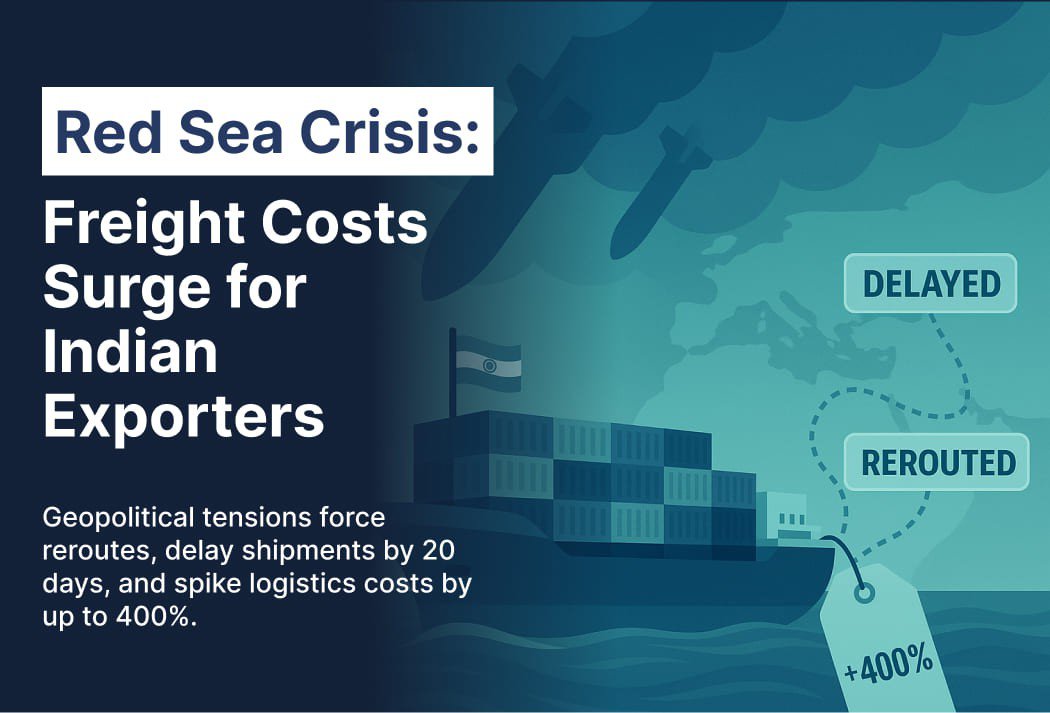
In recent months, rising geopolitical tensions between Iran and Israel, particularly in the Red Sea region, have severely disrupted global shipping routes. For Indian exporters—especially in sectors like agriculture, textiles, and engineering—this isn’t just background news. It’s a serious blow to profitability and competitiveness. With logistics costs increasing by 15–20%, and in some cases even 300–400%, urgent tactical and strategic adjustments are becoming essential.
What’s Driving This Surge?
Lately, rising tensions between Iran and Israel have severely disrupted maritime routes, especially those passing through the Red Sea and the Strait of Hormuz. As a result, sea and air freight costs for Indian goods are estimated to spike by 15–20% Key factors include:
- War‑risk insurance premiums increasing significantly.
- Rerouting ships via longer, costlier voyages around Africa.
- Less vessel availability due to safety diversions and security alerts.
Red Sea Tensions: The Root Cause
The Red Sea, a crucial trade artery, is currently under threat from Houthi militant attacks on cargo vessels. Since October, more than 2,000 ships have been diverted around Africa’s Cape of Good Hope to avoid risk zones—adding nearly 4,000–6,000 nautical miles and 12–20 extra days per trip
One veteran exporter told Mint, costs surged "from $250 to $1,500" for some Middle Eastern routes and from "$700 to $3,500" for voyages to Europe.
The Cost Breakdown
|
Cost Component |
Estimated Increase |
|
Freight rates |
|
|
Insurance premiums |
War-risk surcharges rose from ~0.6% to 2% of cargo value |
|
Fuel & voyage costs |
Longer routes → 12–20+ days extra fuel & operational cost |
|
Delays |
14–20 days in added transit time |
These rising costs aren't marginal—they wipe out exporter margins, making Indian products far less competitive abroad.
Sectoral Impact in India
Export‑oriented industries are directly feeling the pain:
- Agri‑exports (e.g., Basmati rice): Shipments to Iran—India’s major rice consumer—face delays and higher costs. Oil-free barter trade from Pakistan poses further competition.
- Buffalo meat & seafood: Freight costs more than tripled, with shipments delayed by weeks
- Textiles & engineering: Low-margin, high-volume exports—especially to Europe—face a tight squeeze as logistics costs jump 15–20%
- Import chain stress: Rising freight inflates the cost of fertilizer, machinery, consumer electronics, hurting consumers and producers alike .
Macro & Currency Ripples
Rising oil and freight prices are also hitting India’s currency and inflation:
- Brent crude crossed $75 per barrel, rising over 7%, due to regional unrest
- The rupee stayed flat near ₹86/USD, supported partly by exporters hedging dollar earnings
- Still, domestic inflation risk is real: costs being passed down, especially in food, energy, and transport
What Can Exporters Do?
To survive and thrive, exporters should consider:
- Negotiate with carriers: Include contingency clauses, explore multi‐voyage space bookings, shift to long‐term contracts.
- Re-route smartly: Plan transfers at ports less affected by risks; coordinate freight schedules strategically.
- Enhance insurance approaches: Review existing coverage, consider bulk billing, or captive insurance models.
- Hedge fuel costs: Lock-in long-term contracts for bunker fuel to manage volatility.
- Diversify markets: Shift midstream shipments to value-added or premium markets if traditional outlets tighten.
- Leverage government support: Push for export incentives, DAP clauses, state support in insurance and route rerouting.
- Invest in logistics tech: TMS solutions, real-time visibility, and freight cost-forecasting systems can add resilience.
Long-Term Strategic Moves
These short-term shocks highlight broader lessons:
- Diversify supply chains: Integrate rail, air, coastal shipping, and digital platforms to mitigate route dependence
- Strengthen fleet capacity and container manufacturing domestically—reducing reliance on global players
- Accelerate digital control towers, real-time tracking, and AI-led scenario planning to foresee disruptions .
Conclusion
Middle‑East tensions are more than just a geopolitical story—they’re reshaping the logistics economics of Indian exports. With freight rising 20–100%, insurance surging, and routes extended by weeks, export margins are being squeezed tightly. However, by combining tactical cost control, route diversification, insurance negotiation, and digital logistics tools, Indian exporters can build resilient, future-proof supply chains.





 Get instant quote
and compare offers in real time
Get instant quote
and compare offers in real time